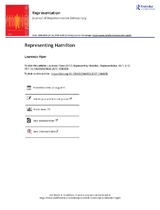| dc.description.abstract | In his most important book to date, Freedom is Power: Liberty Through Political Representation (2014b), Lawrence Hamilton offers what he describes as a realistic theory of freedom for
modern conditions, located in the tradition of Western political thought. It is in fact both a philosophical and a theoretical argument with the former focusing on the link between freedom
and power, and the latter between power and representation, as reflected in the two halves of
the title of the book.
Thus, in the first three chapters of Freedom is Power, Hamilton offers his reading of a longstanding and famous debate on the nature of political freedom, engaging extensively with
varying liberal and republican traditions, and looking to chart a path through them inspired
mostly by Marx. Most of the rest of the book, however, is focused on theorising what
freedom is power would mean under contemporary conditions, starting with critical
debates on power and domination, and moving to his key claim of the centrality of representation (and accountability) to real modern freedom | en_US |

